New workforce generations are giving the workplace revolution renewed life, more urban and mobile.
WORKPLACE TREND
The future is urbane
The suburbs-versus-cities debate about work’s preferred locations masks how both are densifying around transit and encouraging people to leave their cars and walk or bike. Wellness and resilience figure in this shift, but the bigger issue is the need to mix uses to attract the best tenants and enhance their performance. Pairing work with other activities adds urbanity and amenity, and makes development easier to finance.
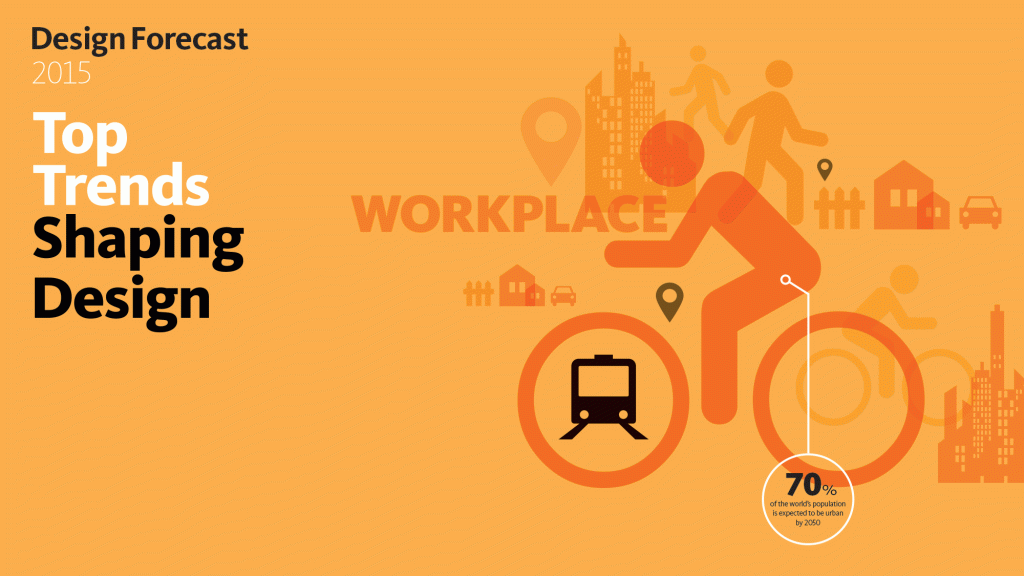
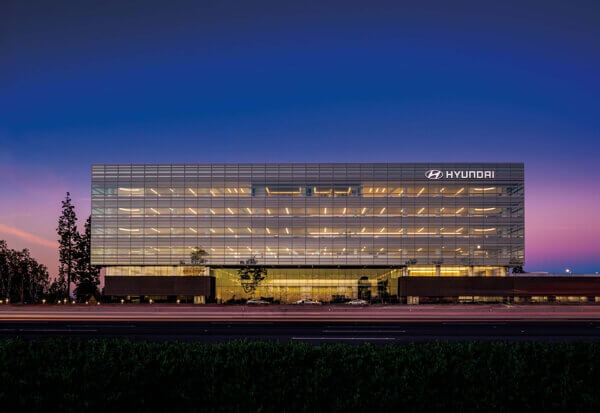
CORPORATE CAMPUSES
TREND 01 Redefining the idea of “campus”
Location is a bigger issue today as companies weigh their workplace needs against the preferences of a workforce that’s in flux. Vertical campuses and repositioned large-floorplate industrial buildings in the urban core will have an edge with Millennials. Yet the traditional corporate campus persists, reflecting the importance of “everyone under one roof” to boost productivity. Whatever the location and format, campuses will promote wellness, integrate and leverage smart technology to increase building performance. But often they’ll do more—adding complementary, even community-serving uses and amenities, and melding non-office and office work together to drive innovation. The form campuses and buildings takes helps forge a strong identity to reinforce corporate culture.
TREND 01 Redefining the idea of “campus”
Location is a bigger issue today as companies weigh their workplace needs against the preferences of a workforce that’s in flux. Vertical campuses and repositioned large-floorplate industrial buildings in the urban core will have an edge with Millennials. Yet the traditional corporate campus persists, reflecting the importance of “everyone under one roof” to boost productivity. Whatever the location and format, campuses will promote wellness, integrate and leverage smart technology to increase building performance. But often they’ll do more—adding complementary, even community-serving uses and amenities, and melding non-office and office work together to drive innovation. The form campuses and buildings takes helps forge a strong identity to reinforce corporate culture.
A CAMPUS THAT CONNECTS — Hyundai Motor America, Fountain Valley, CA
Corporate campuses are shedding their stodgy image as disconnected, disparate buildings. By consolidating operations “under one roof,” companies maximize interactions, foster collaboration and innovation, and promote a sense of community.
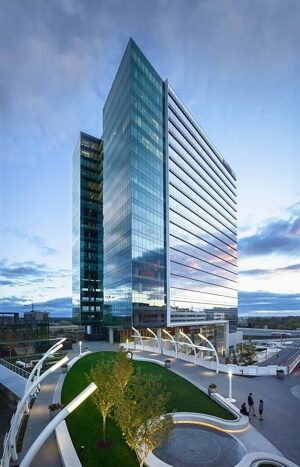
COMMERCIAL OFFICE BUILDING DEVELOPERS
TREND 02 A building type in transition
Developers are transforming the commercial office building model as they refocus on their tenants’ need to recruit a younger, more creative and collaborative workforce. Its preference for buildings that map to its values puts a premium on sustainability, wellness, loft-like spaces, and locations that are active, transit-friendly, and walkable. As this suggests, another big shift is that office buildings are less of a stand-alone real estate product and more a part of mixed use. In some cases, the mix still takes the form of towers combining uses in a vertical format. More often, it’s a richer composition that combines different scales and blends the program imaginatively to promote the kind of informal interaction that generates higher retail traffic and evening and weekend activity.
SUBURBIA TRANSFORMED — Tysons Tower, Tysons Corner, VA Growth pressures downtown are having ripple effects in the suburbs. In places like Tysons Corner, Virginia, the extension of the metro area’s transit network and new interest in mixed-use development are creating urban centers on the fringe.
TREND 02 A building type in transition
Developers are transforming the commercial office building model as they refocus on their tenants’ need to recruit a younger, more creative and collaborative workforce. Its preference for buildings that map to its values puts a premium on sustainability, wellness, loft-like spaces, and locations that are active, transit-friendly, and walkable. As this suggests, another big shift is that office buildings are less of a stand-alone real estate product and more a part of mixed use. In some cases, the mix still takes the form of towers combining uses in a vertical format. More often, it’s a richer composition that combines different scales and blends the program imaginatively to promote the kind of informal interaction that generates higher retail traffic and evening and weekend activity.
SUBURBIA TRANSFORMED — Tysons Tower, Tysons Corner, VA Growth pressures downtown are having ripple effects in the suburbs. In places like Tysons Corner, Virginia, the extension of the metro area’s transit network and new interest in mixed-use development are creating urban centers on the fringe.
CONSULTING
TREND 03
Making change management work
Change today is relentless and getting more so! Along with a climate of disruption, the global nature of business make cultural integration even harder. The workplace is the center of the action. Factors like workforce mobility and higher real estate densities make it much harder for organizations to leverage change to realize their vision of the future. They have to achieve that kind of transformation, yet 70 percent of change initiatives fail! But failure isn’t an option, so a revolution in change management is unfolding. The new approach will use social media to get end-user feedback. Integrating the organization’s business goals, strategies and metrics, and its evolving brand and culture, the process can be tailored to ensure a successful, and transformative outcome.
TREND 03
Making change management work
Change today is relentless and getting more so! Along with a climate of disruption, the global nature of business make cultural integration even harder. The workplace is the center of the action. Factors like workforce mobility and higher real estate densities make it much harder for organizations to leverage change to realize their vision of the future. They have to achieve that kind of transformation, yet 70 percent of change initiatives fail! But failure isn’t an option, so a revolution in change management is unfolding. The new approach will use social media to get end-user feedback. Integrating the organization’s business goals, strategies and metrics, and its evolving brand and culture, the process can be tailored to ensure a successful, and transformative outcome.
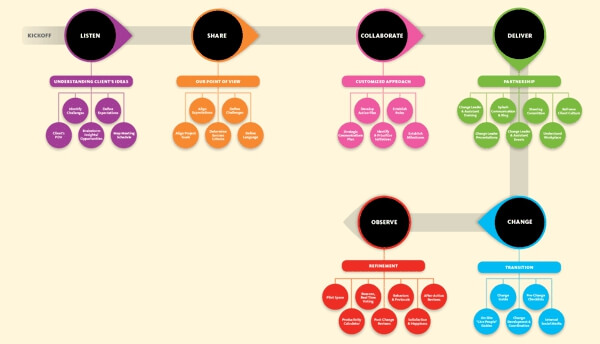
TRANSFORMATIONAL CHANGE is guided by business goals, strategies, and metrics, and grounded in evolving brand and culture.
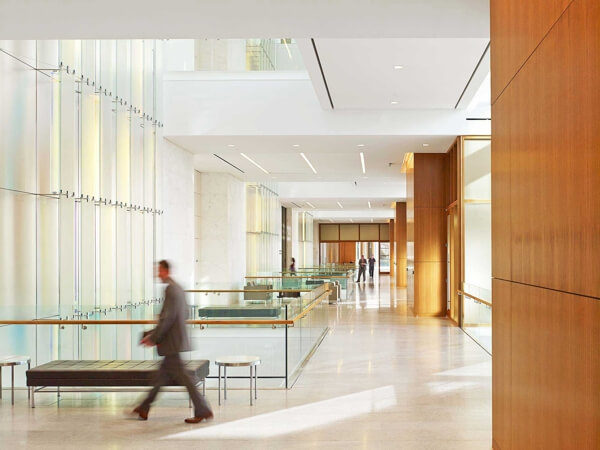
ENERGY
TREND 04
Staying agile in a volatile world
The energy industry understands volatility. Energy firms navigate the world’s markets, regulations, and tax regimes. They contend with mergers, acquisitions, and spinoffs. Technology evolves and so do they. In a volatile world, agility is prized, so the future energy workplace will be flexible, adaptable, and fit to the purpose. Intensively used, the workplace embodies a no-waste ethic. So it’s efficient, but it’s also sustainable and healthy. For the sector, one organizational imperative is to align: one brand, mission, purpose, and workforce. Another is to deliver: supporting knowledge sharing, teaming, and a culture of innovation and “get it done.” The energy industry is a pioneer in working the global/local terrain, staying agile and connected while attending to the bottom line.
TREND 04
Staying agile in a volatile world
The energy industry understands volatility. Energy firms navigate the world’s markets, regulations, and tax regimes. They contend with mergers, acquisitions, and spinoffs. Technology evolves and so do they. In a volatile world, agility is prized, so the future energy workplace will be flexible, adaptable, and fit to the purpose. Intensively used, the workplace embodies a no-waste ethic. So it’s efficient, but it’s also sustainable and healthy. For the sector, one organizational imperative is to align: one brand, mission, purpose, and workforce. Another is to deliver: supporting knowledge sharing, teaming, and a culture of innovation and “get it done.” The energy industry is a pioneer in working the global/local terrain, staying agile and connected while attending to the bottom line.
FLEXIBLE FOR GROWTH — Devon Energy World Headquarters, Oklahoma City, OK
For energy companies, always in fierce competition for talent, a flexible, efficient workplace can be a catalyst for change, allowing for future growth. Amenities, from cafés to wellness centers, cater to a new generation of workers.
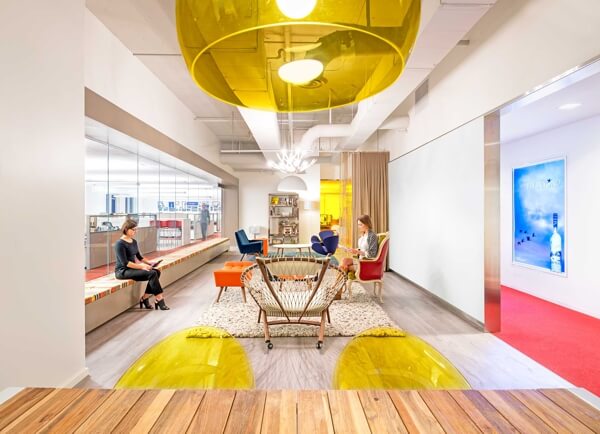
Consumer Products
TREND 05
It’s about the brand
Consumer products firms have always lived their brands. In the past this meant focusing on the products, but now they’re shifting to the customer lifestyles their products complement. There’s an emphasis on customer touch points. The idea is to invoke customers experientially so their influence is felt in relation to evolving the brand and products. There can be an artisanal aspect to these companies. Others identify with where the products are sold or to the ambiance they invoke. Invoking these touchstones can be helpful to people’s creativity, so finding them referenced in the workplace isn’t unusual. That immersive context cements an emotional tie with the brand and products that promotes customer empathy and the innovations that keep both relevant and fresh.
TREND 05
It’s about the brand
Consumer products firms have always lived their brands. In the past this meant focusing on the products, but now they’re shifting to the customer lifestyles their products complement. There’s an emphasis on customer touch points. The idea is to invoke customers experientially so their influence is felt in relation to evolving the brand and products. There can be an artisanal aspect to these companies. Others identify with where the products are sold or to the ambiance they invoke. Invoking these touchstones can be helpful to people’s creativity, so finding them referenced in the workplace isn’t unusual. That immersive context cements an emotional tie with the brand and products that promotes customer empathy and the innovations that keep both relevant and fresh.
UNEXPECTED PLACES — Bacardi, Coral Gables, FL
Consumer products companies are experimenting with physical settings to foster innovation and improve speed-to-market. Inspiration comes from unexpected places, so there’s a mix of quiet/loud, dark/light, and serious/playful spaces.
LANDLORD SERVICES
TREND 06
Relevance is leasing power
The mantra of real estate owners and managers is market relevance. That means active management of the assets, investing to attract the most desirable tenants and support new cohorts of end users. The Millennial generation and its creative employers are looking for the play of imagination in the buildings they inhabit. Both expect spaces that can be reshaped on the fly to suit their changing needs. Both want amenities that cater to their social nature. Both like things urban, but there are many ways to provide it. All of this points to a rising tide of buildings that will be repositioned, rethought, and upgraded. Literally every building type is in play now, including towers in the downtown core. Tapping new technologies and systems makes the remaking cost-effective and ROI-attuned.
TREND 06
Relevance is leasing power
The mantra of real estate owners and managers is market relevance. That means active management of the assets, investing to attract the most desirable tenants and support new cohorts of end users. The Millennial generation and its creative employers are looking for the play of imagination in the buildings they inhabit. Both expect spaces that can be reshaped on the fly to suit their changing needs. Both want amenities that cater to their social nature. Both like things urban, but there are many ways to provide it. All of this points to a rising tide of buildings that will be repositioned, rethought, and upgraded. Literally every building type is in play now, including towers in the downtown core. Tapping new technologies and systems makes the remaking cost-effective and ROI-attuned.
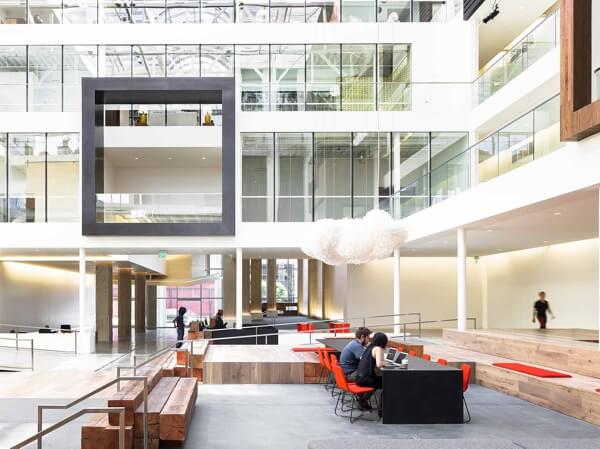
RENEWED AND REPURPOSED — 888 Brannan, San Francisco
Repositioning older buildings is a big market in US cities like San Francisco, where building stock is limited. Converting industrial warehouses into modern, vibrant workspaces that foster creativity and innovation lures new tenants.
TECHNOLOGY
TREND 07 Tech is impacting real estate
Tech companies of all stripes run at a faster pace than many other sectors. Their planning horizons fluctuate, so the ability to turn on a dime is crucial. Making sense of this at different stages in a tech company’s evolution is an ongoing challenge. It leads to surprising twists and turns. Some companies favor large-floorplate campuses to get everyone under one roof and boost productivity; others lean toward urban vertical campuses to attract talent. Tech is fixated on metrics, so it wants realtime data on its buildings. Tech disrupts, so it’s questioning how buildings work. That means redefining their performance and exploring innovations like untethered power. Tech is wide open to change, so it’s prepared to support a range of work styles that includes making and thinking.
EMBRACING DISRUPTION — Motorola Mobility headquarters, Chicago Whether they’re on suburban campuses or in urban hubs, tech companies embrace disruption, encouraging employees to express their personality, adopt work styles that suit them, and “hack” their workspace to meet evolving needs.
TREND 07 Tech is impacting real estate
Tech companies of all stripes run at a faster pace than many other sectors. Their planning horizons fluctuate, so the ability to turn on a dime is crucial. Making sense of this at different stages in a tech company’s evolution is an ongoing challenge. It leads to surprising twists and turns. Some companies favor large-floorplate campuses to get everyone under one roof and boost productivity; others lean toward urban vertical campuses to attract talent. Tech is fixated on metrics, so it wants realtime data on its buildings. Tech disrupts, so it’s questioning how buildings work. That means redefining their performance and exploring innovations like untethered power. Tech is wide open to change, so it’s prepared to support a range of work styles that includes making and thinking.
EMBRACING DISRUPTION — Motorola Mobility headquarters, Chicago Whether they’re on suburban campuses or in urban hubs, tech companies embrace disruption, encouraging employees to express their personality, adopt work styles that suit them, and “hack” their workspace to meet evolving needs.
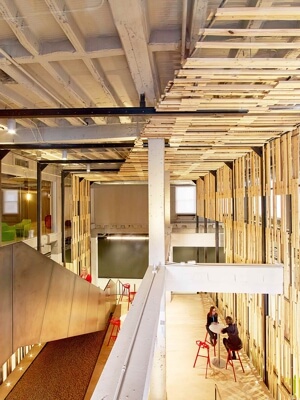
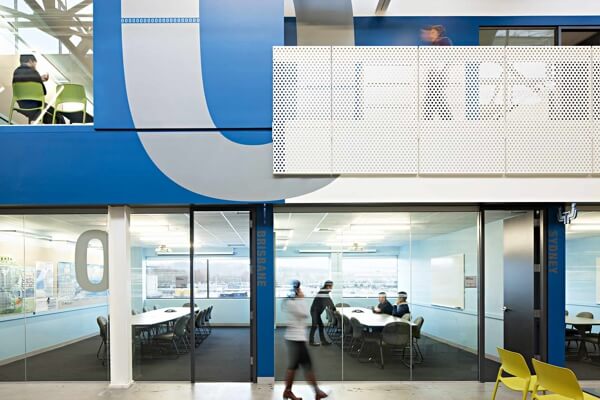
DEFENSE & AEROSPACE
TREND 08
Secure, urban, and collaborative Security is a given in this sector, but the companies will be under greater pressure to find the best employees, balance work modes, and broaden their locational options. Urban areas with transit access and a mix of nearby amenities are in play, adding a layer of security requirements for the owners and developers of buildings catering to the sector. Also reshaping the workplace for these companies is their need to align engineering and product fabrication with each other and with broader business goals. This will help them get to market faster without compromising product quality. Facilities need to support cross-team collaboration and let teams reshape the workspace to meet their evolving needs. Analyzing workflow in human terms will be key to their design.
TREND 08
Secure, urban, and collaborative Security is a given in this sector, but the companies will be under greater pressure to find the best employees, balance work modes, and broaden their locational options. Urban areas with transit access and a mix of nearby amenities are in play, adding a layer of security requirements for the owners and developers of buildings catering to the sector. Also reshaping the workplace for these companies is their need to align engineering and product fabrication with each other and with broader business goals. This will help them get to market faster without compromising product quality. Facilities need to support cross-team collaboration and let teams reshape the workspace to meet their evolving needs. Analyzing workflow in human terms will be key to their design.
A SYNTHESIZED WORKPLACE — Boeing, Renton, Washington
Whenever manufacturing has to interact with other work activities, acoustical separation is an issue. Creating office space within a larger space yields physical separation, while still allowing visibility and interaction among staff.
GOVERNMENT
TREND 09
Doing more with less
In the US, government at every level is looking for ways to provide services at lower cost. Following the lead of the Federal government, its regional and local counterparts are implementing new workplace standards, integrating mobility strategies, and streamlining their portfolios by consolidating at a higher workplace density. They’re also reducing operating costs by embracing sustainable, high-performing design and systems. To address the limits of public-sector budgets, governments will increasingly be partnering with private-sector developers, facility managers, and other providers. While competitively chosen, these partners will be brought into projects earlier as advisors on portfolio strategy and state-of-the-art workplace requirements.
TREND 09
Doing more with less
In the US, government at every level is looking for ways to provide services at lower cost. Following the lead of the Federal government, its regional and local counterparts are implementing new workplace standards, integrating mobility strategies, and streamlining their portfolios by consolidating at a higher workplace density. They’re also reducing operating costs by embracing sustainable, high-performing design and systems. To address the limits of public-sector budgets, governments will increasingly be partnering with private-sector developers, facility managers, and other providers. While competitively chosen, these partners will be brought into projects earlier as advisors on portfolio strategy and state-of-the-art workplace requirements.
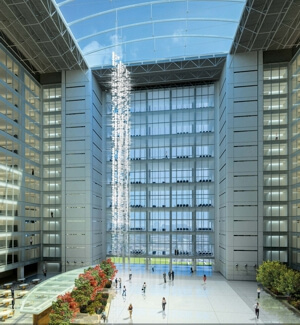
A MODERNIZED WORKPLACE — Federal agency offices, Rockville, MD
Government agencies are stepping up their game and honing in on modern, sustainable office buildings that are cost-efficient, utilizing the latest technologies while meeting security, sustainability, and workplace design mandates.

MEDIA
TREND 10
Still a studio at heart The media sector is in growth mode as the hunger for digital content surges. A proliferating array of channels, venues, and distributors makes the creation cycle shorter and shorter. Media work is fluid, intense, and highly collaborative. The technology is getting smaller and smarter, shifting the work itself from the equipment-heavy context that’s still the sector’s image, but this is a creative industry with an attitude that’s true to studio traditions. Media workspace will be open, amenity-filled, flexible in relation to new technologies, and capable of being scaled up fast for growth. Fans are important for this sector: online game creators’ global fan base fills stadiums for their annual championships. While fans won’t crowd their workplace, they may need to welcome them.
TREND 10
Still a studio at heart The media sector is in growth mode as the hunger for digital content surges. A proliferating array of channels, venues, and distributors makes the creation cycle shorter and shorter. Media work is fluid, intense, and highly collaborative. The technology is getting smaller and smarter, shifting the work itself from the equipment-heavy context that’s still the sector’s image, but this is a creative industry with an attitude that’s true to studio traditions. Media workspace will be open, amenity-filled, flexible in relation to new technologies, and capable of being scaled up fast for growth. Fans are important for this sector: online game creators’ global fan base fills stadiums for their annual championships. While fans won’t crowd their workplace, they may need to welcome them.
OPEN AND AMENITY-FILLED — Zimmerman, an Omnicom Company, Fort Lauderdale, FL
An open interconnecting stair facilitates chance meetings and idea exchange at Zimmerman Omnicom. All three floors feature a central “collaboration ribbon” that balances formal conference rooms and informal areas for screening ads.
FINANCIAL SERVICES FIRMS
TREND 11
Embracing new realities
As financial services shifts to apps and other digital interfaces with customers, the sector is seeing growth of tech and digital innovation teams. Especially in tech-centric cities, competition for the best and brightest is intense. When the work is collaborative, the teams need workspace that’s atypical of the sector generally, but maps well to the desire of younger employees for settings that inspire creativity. The need to make protocols and policies more transparent in finance is leading US firms to embrace open plan. With the right features, it lets people “scan the room” and interact spontaneously, but also access spaces with privacy when needed. Asia’s limited stock of Class A buildings means activity-based work settings are necessary to accommodate future growth.
TREND 11
Embracing new realities
As financial services shifts to apps and other digital interfaces with customers, the sector is seeing growth of tech and digital innovation teams. Especially in tech-centric cities, competition for the best and brightest is intense. When the work is collaborative, the teams need workspace that’s atypical of the sector generally, but maps well to the desire of younger employees for settings that inspire creativity. The need to make protocols and policies more transparent in finance is leading US firms to embrace open plan. With the right features, it lets people “scan the room” and interact spontaneously, but also access spaces with privacy when needed. Asia’s limited stock of Class A buildings means activity-based work settings are necessary to accommodate future growth.
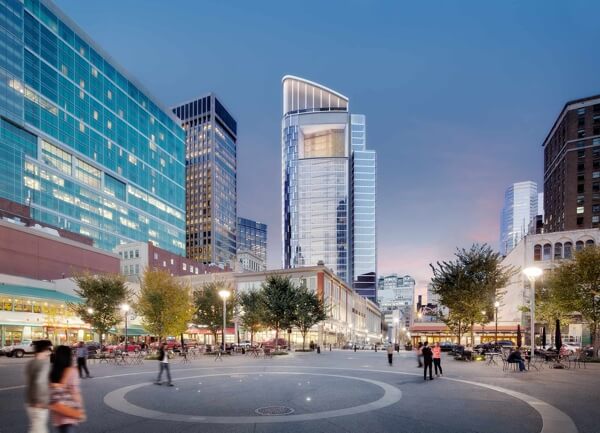
WORKPLACE INNOVATOR — The Tower at PNC Plaza, Pittsburgh
The Tower at PNC Plaza reflects PNC’s commitment to an innovative workplace that supports employee satisfaction and productivity. The tower offers amenities such as access to fresh air, natural light, and large collaboration spaces.
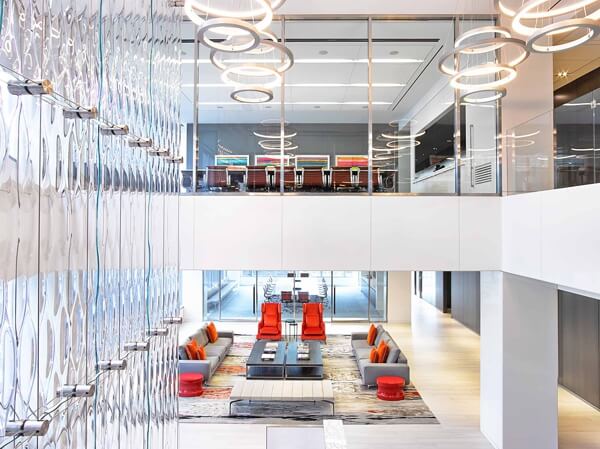
PROFESSIONAL SERVICES FIRMS
TREND 12
Mobile, engaged, and future-proof To increase real estate efficiency, professional services firms will continue to reduce space. This high-performance workplace will consist of a variety of settings that provide choice and balance among work modes. Technology will be an enabler of communication and mobility wherever work happens. The office will be the focus of face-to-face engagement with clients and colleagues. Future-proofing will be a high priority, with greater flexibility to accommodate head-count shifts and evolving work styles cost-effectively within the same footprint. Coworking space is on the horizon for professional services firms with creative sector clients and a Millennial workforce. Coworking can be a catalyst for inspiring and supporting the kind of spontaneous interaction that generates and speeds innovation.
TREND 12
Mobile, engaged, and future-proof To increase real estate efficiency, professional services firms will continue to reduce space. This high-performance workplace will consist of a variety of settings that provide choice and balance among work modes. Technology will be an enabler of communication and mobility wherever work happens. The office will be the focus of face-to-face engagement with clients and colleagues. Future-proofing will be a high priority, with greater flexibility to accommodate head-count shifts and evolving work styles cost-effectively within the same footprint. Coworking space is on the horizon for professional services firms with creative sector clients and a Millennial workforce. Coworking can be a catalyst for inspiring and supporting the kind of spontaneous interaction that generates and speeds innovation.
RECONFIGURABLE SPACE — Morrison Foerster, New York
Future law offices will be smaller, adaptable, more collaborative, and technology-rich, as evidenced in “Redesign Law,” Gensler’s exhibit for the 2014 Association of Legal Administrators Conference. For more, visit: www.redesign-law.com.
PRODUCT DESIGN
TREND
13
Multiple sources of innovation
The current revolution in materials and fabrication methods will push products in new directions. So will tech developments that improve the qualities and metrics buyers value. An important product design focus will be on prototypes that can be tailored to specific markets without undue expense.Yet those markets are a growing source of ideas for new products. Large cities in particular serve as micro-markets for products, with an outsize influence on consumers elsewhere. As such, they function as innovation hubs. This is why firms are locating their innovation labs where the action is, rather than closer to home. As the Internet of Things gets traction, products will be “in conversation” with other products and systems, and with companies that maintain, repair, or replace them.
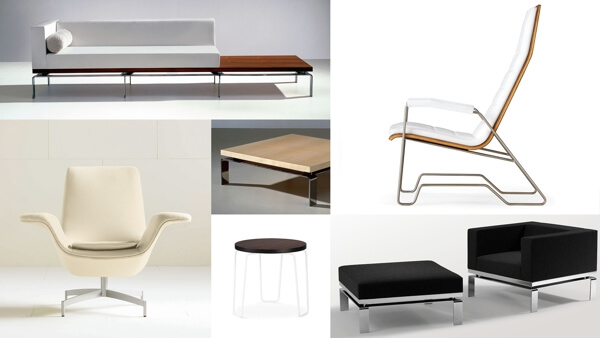
DESIGNING FOR THE END USER
As strategists and designers, we work with manufacturers to bring a unique, experiential, user-based perspective to product design. Our growing catalogue of products reflects our knowledge of end-user trends across sectors and borders.
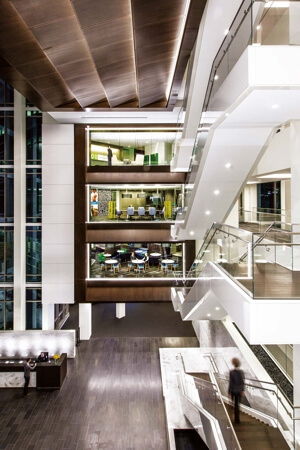
Life Sciences
TREND 14
A fast-evolving workplace
Technology is transforming the life sciences workplace in significant ways. For example, it is making lab spaces more modular and flexible. Traditional labs are being supplanted by technically complex workspaces that support the latest scientific advances. This is freeing researchers to form interdisciplinary teams and collaborate synergistically with scientists of different types. Companies and institutions are competing for an emerging generation of researchers who prize creativity and want to make a meaningful contribution to society. The trend in life sciences is to integrate the methods and means of advanced research with the qualities of place that spark connection and interaction among researchers, locally and globally, so innovation happens faster.
RETHINKING THE LAB — Mylan, Canonsburg, PA Life science companies are promoting greater transparency and interaction between flexible office space and lab environments. A collaborative, technology-rich environment promotes innovation and faster decision making.
TREND 14
A fast-evolving workplace
Technology is transforming the life sciences workplace in significant ways. For example, it is making lab spaces more modular and flexible. Traditional labs are being supplanted by technically complex workspaces that support the latest scientific advances. This is freeing researchers to form interdisciplinary teams and collaborate synergistically with scientists of different types. Companies and institutions are competing for an emerging generation of researchers who prize creativity and want to make a meaningful contribution to society. The trend in life sciences is to integrate the methods and means of advanced research with the qualities of place that spark connection and interaction among researchers, locally and globally, so innovation happens faster.
RETHINKING THE LAB — Mylan, Canonsburg, PA Life science companies are promoting greater transparency and interaction between flexible office space and lab environments. A collaborative, technology-rich environment promotes innovation and faster decision making.

